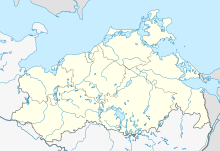Dünenheide nature reserve on the island of Hiddensee
Coordinates: 54 ° 32 ′ 41.1 ″ N , 13 ° 6 ′ 17.3 ″ E
The nature reserve Dünenheide on the island of Hiddensee is a 75 hectare nature reserve south of the village of Vitte . In the area of the German Baltic coast, it is the last large coastal heath . It was placed under protection in 1964, the area was reduced in size in 1990. The state of the area is good, as the immigration of woody plants has been slowed down through maintenance measures.
history
The area was created as a beach wall fan as part of the compensation coast . Due to the typical strong westerly winds, dunes up to five meters high formed in the western part. To the east, within the protected area boundaries, there is a sea sand plain, which merges into a coastal flood moor in the area of the lagoon coast.
Due to the low profitability of the soil, the areas were only used as sheep pasture for centuries. Raw humus from the heather was taken as stable litter and building material. Population increases in the 17th and 18th centuries Century led to overuse of the area until the middle of the 20th century. From 1906 coastal protection forests were planted on the west coast. In 1965 the dune heath was used for tourism. A holiday village with summer houses was built in the southern part of the area.
Flora
The dune area is characterized as gray and brown dunes with interspersed dune bogs in the depressions. Typical representatives of the heather plants are crowberry , heather and creeping willow . There are numerous types of lichens .
literature
- Dune heather on the island of Hiddensee 295. In: Lebrecht Jeschke: The nature reserves in Mecklenburg-Western Pomerania . Published by the Mecklenburg-Western Pomerania Ministry of the Environment. Demmler-Verlag, Schwerin 2003, ISBN 3-910150-52-7 , p. 103 f.
- Schröder, C .: The Hiddensees heathland. An overview of the past 150 years of cultural landscape history. (PDF; 9.1 MB) 2008, p. 154 , accessed on June 14, 2009 .



